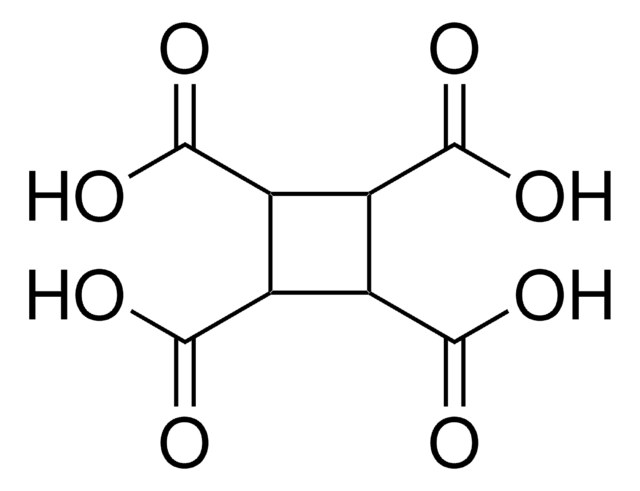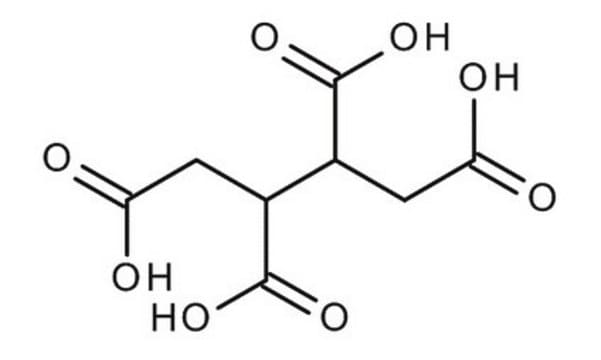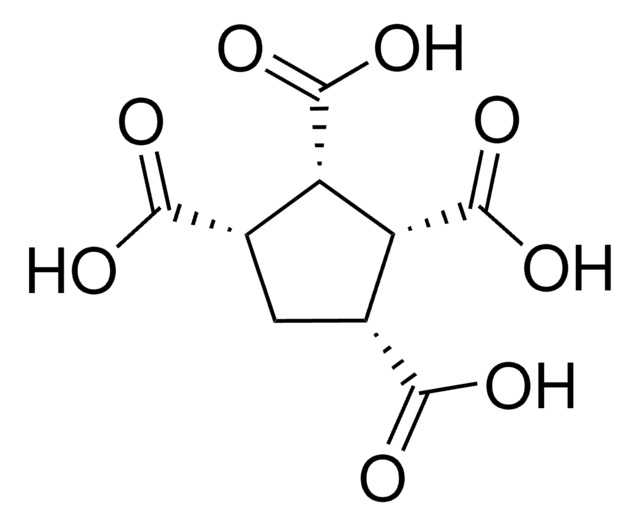All Photos(3)
About This Item
Linear Formula:
[-CH(CO2H)CH2CO2H]2
CAS Number:
Molecular Weight:
234.16
Beilstein:
1729167
EC Number:
MDL number:
UNSPSC Code:
12162002
PubChem Substance ID:
NACRES:
NA.23
Recommended Products
Assay
99%
form
powder
mp
195-197 °C (dec.) (lit.)
SMILES string
OC(=O)CC(C(CC(O)=O)C(O)=O)C(O)=O
InChI
1S/C8H10O8/c9-5(10)1-3(7(13)14)4(8(15)16)2-6(11)12/h3-4H,1-2H2,(H,9,10)(H,11,12)(H,13,14)(H,15,16)
InChI key
GGAUUQHSCNMCAU-UHFFFAOYSA-N
Looking for similar products? Visit Product Comparison Guide
General description
1,2,3,4-Butanetetracarboxylic acid (BTCA) is utilized as a cross-linking agent and as a building block for the synthesis of specialized polymers for the formulation of resins, polymers, coatings, and adhesives.
Application
1,2,3,4-Butanetetracarboxylic acid (BTCA) can be used as a cross-linking agent:
- To functionalize cotton fabric. BTCA-treated fabric shows improved anti-pilling, wrinkle resistance, and fire-retardant properties.
- To fabricate flexible, free-standing nanocellulose membranes. The cross-linking with BTCA improves water stability and ionic conductivity of membranes.
Signal Word
Warning
Hazard Statements
Precautionary Statements
Hazard Classifications
Acute Tox. 4 Oral - Eye Irrit. 2
Storage Class Code
11 - Combustible Solids
WGK
WGK 3
Flash Point(F)
Not applicable
Flash Point(C)
Not applicable
Personal Protective Equipment
dust mask type N95 (US), Eyeshields, Gloves
Choose from one of the most recent versions:
Already Own This Product?
Find documentation for the products that you have recently purchased in the Document Library.
Asli Celebioglu et al.
Scientific reports, 7(1), 7369-7369 (2017-08-09)
Water pollution is a serious concern for public health and environment in today's world; hence, there exists a strong demand to develop cost-effective, sustainable and eco-friendly membranes. Here, we produce a highly efficient molecular filter membrane based on bio-renewable material;
Peipei Wang et al.
Carbohydrate polymers, 218, 103-111 (2019-06-22)
Environmentally friendly, sustainable, and high-performance thermal insulators are in high demand. Petroleum-based insulator foams usually have high thermal conductivity and pose health hazards. Here, we report ultralight composite foams that are highly strong, elastic, and super-insulating. The foams are composed
Bolin Ji et al.
Carbohydrate polymers, 207, 288-296 (2019-01-03)
The sodium l-glutamate is reported as an efficient catalyst for the cross-linking between 1,2,3,4-butanetetracarboxylic acid (BTCA) and cellulose. Results presented ester absorbance of the treated fabrics strongly increased in the presence of the homemade l-glutamate salt, a mixture of l-glutamic
Gun Jin Kim et al.
Scientific reports, 10(1), 18858-18858 (2020-11-04)
Micro- and nanofiber (NF) hydrogels fabricated by electrospinning to typically exhibit outstanding high porosity and specific surface area under hydrated conditions. However, the high crystallinity of NFs limits the achievement of transparency via electrospinning. Transparent poly(vinyl alcohol)/β-cyclodextrin polymer NF hydrogels
Eduardo de O Sanguinet et al.
Journal of biomedical materials research. Part B, Applied biomaterials, 108(3), 857-867 (2019-06-30)
Induced pluripotent stem cells (iPSCs) provide a promising means of creating custom-tailored cell lines for cellular therapies. Their application in regenerative medicine, however, depends on the possibility that the maintenance and differentiation of cells and organs occur under defined conditions.
Our team of scientists has experience in all areas of research including Life Science, Material Science, Chemical Synthesis, Chromatography, Analytical and many others.
Contact Technical Service









